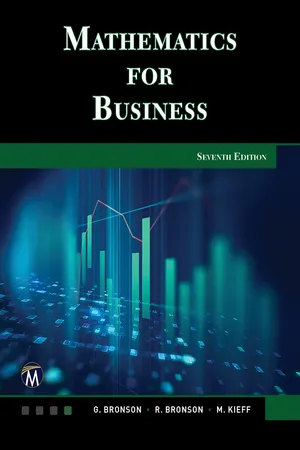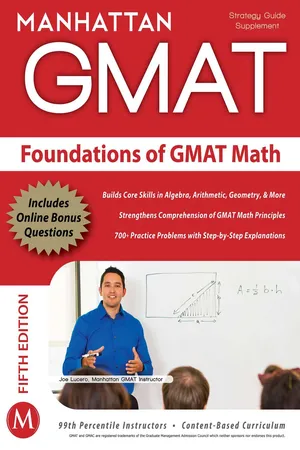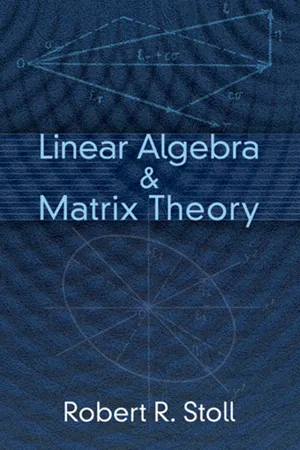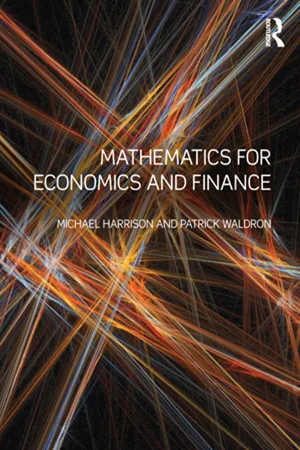Mathematics
Quadratic functions
Quadratic functions are second-degree polynomial functions that can be expressed in the form f(x) = ax^2 + bx + c, where a, b, and c are constants and a is not equal to 0. These functions graph as parabolas and have a single, symmetrically placed vertex. They are widely used in mathematics and physics to model various real-world phenomena.
Written by Perlego with AI-assistance
Related key terms
7 Key excerpts on "Quadratic functions"
- eBook - ePub
- Gary Bronson, Richard Bronson, Maureen Kieff(Authors)
- 2021(Publication Date)
- Mercury Learning and Information(Publisher)
Quadratic functions , and have the form:f (x ) = a 2 x 2 + a 1 x + a 0where a 2 ≠ 0. If we replace the constants a 2 , a 1 , and a 0 , by a , b , and c , respectively, this second-degree polynomial function is written in its more conventional form as:y = ax 2 bx + c (Eq. 3.8)In Equation 3.8, the variable that is squared is referred to as the quadratic variable , which in this case is x . Note that what determines if an equation is a function are not the symbols used in the equation, but whether the equation, domain, and range satisfy the definition of a function provided in Section 3.1 .Example 1 Determine which of the following functions are Quadratic functions. For those that are, state their coefficients, a, b, and c.a. y = 2x 2 − ½b. y = 3x − x 2c. n 2 = 2p + 4Solutiona. This is a quadratic function in the variable x with a = 2, b = 0, and c = − 1/2.b. Rewriting this equation as y = − x 2 + 3x , we see that this is a quadratic function in the variable x with a = − 1, b = 3, and c = 0.c. Rewriting this equation as f (p ) = 1/2 n 2 − 2, we see that it is a quadratic function in the variable n , with a = ½, b = 0, and c = − 2.As in the case of linear equations and in part (c) of this example, the letters y and x - eBook - ePub
Differentiating Instruction in Algebra 1
Ready-to-Use Activities for All Students (Grades 7-10)
- Kelli Jurek(Author)
- 2021(Publication Date)
- Routledge(Publisher)
Unit 4Quadratic functions DOI: 10.4324/9781003234180-5The final unit focuses on Quadratic functions. Students will continue their study of nonlinear functions by identifying Quadratic functions in tables, graphs, and equations and identifying the characteristics of quadratics. Real-life applications introduced through story problems are included in most lessons. The final project, which could be used as an authentic assessment, is a catapult project.This unit begins with a pretest and four real-life applications of Quadratic functions that can be discussed in small groups and then as a larger group. Many of the activities will offer the students an opportunity to choose learning activities according to their learning style, personal interests, and readiness level.What Do We Want Students to Know?
Common Core State Standards Addressed:• A.SSE.3a, 3b• AAPR.3• A.CED.2• A.REI.4a, 4b• F.IF.4, 6, 7a, 8a, 9• F.BF.1 Big Ideas• Quadratics are parabolas and must have a 2 as their highest exponent.• The zeros/solutions are where the parabola crosses the x-axis.• There are different ways to solve quadratics.• Different forms of quadratics provide different key information.• Quadratics can model many real-world situations. Essential Questions• What does it mean to find the zeros/solutions?• What is a parabola?• How do I determine the best method to solve a quadratic?• What information do I need to sketch a quadratic? Critical Vocabulary
Parabola Function x-intercept y-intercept Zeros(roots) Axis of symmetry Maximum value Minimum value Vertex Quadratic function Quadratic formula First differences Second differences Terms Unit Objectives
- eBook - ePub
- Manhattan GMAT(Author)
- 2011(Publication Date)
- Manhattan Prep Publishing(Publisher)
Chapter 7: Quadratic EquationsIn This Chapter:• Manipulating quadratic expressions and solving quadratic equations Mechanics of Quadratic Equations In high school algebra, you learned a number of skills for dealing with quadratic equations. For the GMAT, you need to relearn those skills.Let's define terms first. A quadratic expression contains a squared variable, such as x2 , and no higher power. The word “quadratic” comes from the Latin word for “square.” Here are a few quadratic expressions:
A quadratic expression can also be disguised. You might not see the squared exponent on the variable explicitly. Here are some disguised quadratic expressions.z2 y2 + y – 6 x2 + 8x + 16 w2 – 9 z × z (y + 3)(y – 2) (x + 4)2 (w – 3)(w + 3) If you multiply these expressions out—that is, if you distribute them—then you see the exponents on the variables. Note that the second list corresponds to the first list exactly.A quadratic equation contains a quadratic expression and an equals sign.Quadratic expression = something elseA quadratic equation usually has two solutions. That is, in most cases, two different values of the variable each make the equation true. Solving a quadratic equation means finding those values.Before you can solve quadratic equations, you have to be able to distribute and factor quadratic expressions.Distribute (a + b)(x + y) Use FOILRecall that distributing means applying multiplication across a sum.
You can omit the multiplication sign next to parentheses. Also, the order of the product doesn't matter, and subtraction works the same way as addition. Here are more examples:= 5 × 3 + 5 × 4 equals five times three plus five times four. - eBook - ePub
- Paul Turner, Justine Wood(Authors)
- 2023(Publication Date)
- Mercury Learning and Information(Publisher)
x -axis than the original curve.FIGURE 2.3 Parabolas with parameters 1 (solid line) and 2 (broken line).REVIEW EXERCISES – SECTION 2.11. Calculate the equations of the straight lines passing through the following pairs of coordinates.(a)(b)(c)2. Given the following equations for straight lines, calculate the values of x, which give(a)(b)(c)3. Variables x and y both vary with time according to the formulas and . This defines a curve in the Cartesian plane. Find the alternative representation in the form of an equation which links y and x .2.2 FUNCTIONSA function is a rule which takes an element from one set and maps it to the elements of another set. Although functions are often written in the form of equations, they are not the same thing.A function is a rule which associates objects in one set with objects in another set. For example, a function could be a rule which takes one number (the argument or input ) and uses it to assign another number (the output or result ). Equations are often used to define the rule, but simply writing down an equation relating two variables is not sufficient to define a function. To fully define a function, we must also specify the sets of numbers which are valid inputs and outputs of the relationship we define. A simple example is an equation of the form . For this to be a function, we must also specify the set of numbers from which x is drawn and the set of numbers that comprises the possible outcomes, y . These are referred to as the domain and the codomain of the function. For example, we can define a function using the relationships shown in (2.1):. (2.1)The first part of the definition consists of the equation . This defines the rule which takes x, the argument of the function, and maps it to y , the output . The second part of this function defines the domain and the codomain. In this example, we say that the function f “maps” the set of integers to the set of integers. The notation can be read as “f maps the set of integers to itself.” Note that the same equation could be used to map the set of real numbers to itself, that is, - eBook - ePub
- Huw Fox, William Bolton(Authors)
- 2002(Publication Date)
- Butterworth-Heinemann(Publisher)
c . The highest power of a variable is 1. This is only one type of function. Here we look at another form, the quadratic function, and examine its defining equation.The term quadratic function is used for a function y = f (x ) where the defining equation has the general form:[7]where a, b and c are constants. The highest power of the variable is 2.Quadratic equations occur often in engineering. An example of such an equation in engineering occurs with the e.m.f. E of a thermocouple which can often be described by:where t is the temperature and a and b are constants. Other examples occur in the relationships for the bending moment M for bending beams, such as that for a cantilever propped at its free end:where x is the distance from the free end of a cantilever of length L and w the distributed load per unit length.The linear equation and the quadratic equation are just two examples of what are termed polynomials . A polynomial is the term used for any equation involving powers of the variable which are positive integers. Such powers can be 1, 2, 3, 4, 5, etc. For example, x 4 + 4x 3 + 2x 2 + 5x + 2 = 0 is a polynomial with the highest power being 4.1.3.1 Factors and roots
Key point We can solve a quadratic equation by:1. Factoring the quadratic. 2. Setting each factor equal to 0. 3. Solving the resulting linear equations.To factorise a number means to write it as the product of smaller numbers. Thus, for example, we can factor 12 to give 12 = 3 × 4. The 3 and 4 are factors of 12. If the 3 and the 4 are multiplied together then 12 is obtained. To factorise a polynomial means to write it as the product of simpler polynomials. Thus for the quadratic expression x 2 + 5x + 6 we can write:(x + 2) and (x + 3) are factors. If the two factors are multiplied together then the x 2 + 5x + 6 is obtained. Note that, in general:[8]If we have u × v = 0 then we must have either u = 0 or v = 0 or both u and v are 0. This is because 0 times any number is 0. Thus if we have the quadratic equation x 2 + 5x + 6 = 0 and rewrite it as (x + 2)(x + 3) = 0, then we must have either x + 2 = 0, or x + 3 = 0 or both equal to 0. This means that the solutions to the quadratic equation are the solutions of these two linear equations, i.e. x = −2 and x = −3. These values are called the roots of the equation. We can check these values by substituting them into the quadratic equation. Thus for x = −2 we have 4 − 10 + 6 = 0 and thus 0 = 0. For x - eBook - ePub
- Robert R. Stoll(Author)
- 2013(Publication Date)
- Dover Publications(Publisher)
CHAPTER 5BILINEAR AND Quadratic functions AND FORMS
5.1. Linear Functions. The classes of functions indicated in the chapter title have widespread utility, as the examples and problems will show. Usually these functions are studied without the aid of vector spaces. However, a vector space is the proper setting for their study, since the procedures followed are entirely natural and easily explained from this viewpoint. For the moment, we shall say merely that bilinear and Quadratic functions are examples of functions with arguments in a vector space V over a field F and values in F , in brief, functions on V to F .In order that the reader may become acquainted with our point of view, we shall begin by discussing an example of a linear function† on a vector space to its coefficient field. Let V = P 3 (C ), the space of all polynomials of degree less than or equal to 2 in a real variable t with complex coefficients. Define the function f on V to C as follows: f ( ) is equal to the value of at t = 1. Clearly f is linear. Relative to the basis { 1 = 1, 2 = t , 3 = t 2 } for V , we haveHere f , a function on V 3 (C ) to C , which is defined by the equation in which it appears, may be used to compute the values of the original function on V to C . Using the terminology introduced below, we call f the representation of f relative to the -basis: its value at X is f ( ) if has -coordinates X .If, instead of the -basis, we choose the basis { = 1, 2 = t − 1, 3 = (t − 1)2 } for V , thenIt is to be observed that the representation f of f relative to the -basis for V is (i) different from the previous representation and (ii) simpler in form than f .Consider next the case of an arbitrary linear function g on an n -dimensional vector space V over F to the scalar field F . As in the foregoing example, it is easy to construct a function on V n (F ) to F that assumes the same values as g . Indeed, if a basis { 1 , 2 , …, n } is chosen for V , define g on V n (F ) to F - eBook - ePub
- Michael Harrison, Patrick Waldron(Authors)
- 2011(Publication Date)
- Routledge(Publisher)
Conic sections, quadratic forms and definite matrices
DOI: 10.4324/9780203829998-6 f4.1 Introduction
So far, we have concentrated on linear equations, which represent lines in the plane, planes in three-dimensional space or, as will be seen in Section 7.4.1 , hyperplanes in higher dimensions. In this chapter, we consider equations that also include second-order or squared terms, and that represent the simplest types of nonlinear curves and surfaces.The concepts of matrix quadratic form and definite matrix are of considerable importance in economics and finance, as will be seen in the detailed study of our several applied examples later. Quadratic forms relate importantly to the algebraic representation of conic sections. Also, in Theorem 10.2.5, it will be seen that the definiteness of a matrix is an essential idea in the theory of convex functions. This chapter gives definitions and simple illustrations of the concepts of quadratic form and definiteness before going on to establish a number of theorems relating to them. We will return to quadratic forms in Chapter 14 , where the important general problem of maximization or minimization of a quadratic form subject to linear inequality constraints is studied.4.2 Conic sections
In this section, we consider equations representing conic sections in two dimensions. There are a number of equivalent ways of describing and classifying conic sections. We begin with a geometric approach.1Consider the curve traced out in the coordinate plane ℝ2 by a point P = (x, y), which moves so that its distance from a fixed point (the focus S ) is always in a constant ratio (the eccentricity ϵ ≥ 0) to its perpendicular distance from a fixed straight line (the directrix L). This curve is called:- an ellipse when 0 < ϵ < 1;
- a parabola when ϵ = 1;
- a hyperbola when ϵ > 1; and
- a circle as ϵ → 0, as we shall see later.
4.2.1 Parabola
Consider first the case of ϵ = 1, i.e. the parabola. The equation of the parabola takes its simplest form when the focus S is a point on the positive x axis, say (a, 0), where a > 0, and the directrix is the vertical line with equation x = −a. An example of a parabola is shown in Figure 4.1
Index pages curate the most relevant extracts from our library of academic textbooks. They’ve been created using an in-house natural language model (NLM), each adding context and meaning to key research topics.






